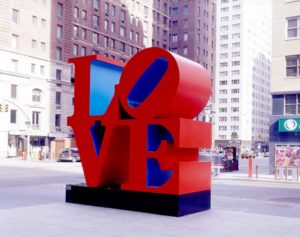
On most days, Hogan Lovells partner Kevin Lipson dives into complex legal matters involving energy regulation law. In fact, he was involved in obtaining the largest settlement in the history of the regulated natural gas business.
But this week, the Houston lawyer strayed from his usual FERC-heavy practice to board a flight to New York and attend what will likely be one of the most talked about auctions in the art world this year.
Lipson represents James W. Brannan, the executor of the estate of famed pop artist Robert Indiana, who died in May of this year of respiratory failure. Proceeds from Friday’s auction, which took place in Manhattan at world-renowned auction house Christie’s, will go toward the ever-growing legal expenses tied to a federal suit that currently puts Indiana’s legacy in jeopardy. Lipson told The Texas Lawbook Friday afternoon that the two pieces Brannan decided to auction sold for $5 million.
Indiana is best known for his “LOVE” sculpture and its many variants, including on stamps and in paintings. Eight years after building the 12-foot-tall steel sculpture version that heightened his fame, Indiana left New York City to live the rest of his life in isolation in Vinalhaven, a remote town on an island in Maine.
The lawsuit, filed in Manhattan federal court, was brought one day before Indiana’s May 19 death. In the suit, Indiana’s longtime agent, Morgan Art Foundation (“MAF” for short in the pleadings), alleges Indiana’s caretaker and art publisher isolated Indiana in his last years from friends and supporters in the art community so they could sell forged artwork attributed to Indiana for millions of dollars. The plaintiff alleges this diminishes the value of the authentic pieces that MAF owns the rights to.
Though Indiana “went through a number of lawyers,” Brannan, a Rockland, Maine-based general practitioner, became the executor of the artist’s estate because Brannan was the final lawyer Indiana settled on to develop his will, Lipson said.
Lipson, who also has a house in midcoast Maine, said he got hired to represent Brannan because they have known each other for 30 years. In fact, Lipson has used Brannan as his own lawyer. Lipson also attributed the fact that Brannan is “very familiar with the reputation of Hogan Lovells.”
This includes Brannan’s friendship with Chief U.S. Supreme Court Justice John Roberts, who is a Hogan Lovells alum and owns property in the St. George peninsula of Maine, near Lipson’s house. Brannan also represented Chief Justice Roberts in his real estate transaction.
“I deal with one fine art lawyer who represents a gallery in Switzerland that has a lot of Indiana works,” Lipson said. “He was struck by me representing Indiana because I’m an energy lawyer. He said, ‘You know, Kevin, in New York there are only about 10 fine art lawyers.’ I say, ‘Well, now there are 11.’ We have evolved as a firm with a very strong capability in dealing with IP issues or litigation issues associated with representing artists, museums or galleries.”
The lawsuit in the Southern District of New York names Indiana’s caretaker and power of attorney, Jamie Thomas; New York agent Michael McKenzie; and his company, American Image Art, as defendants. It also names Indiana’s estate as a defendant, but, as the plaintiff states in court documents, “only because his (Indiana’s) inclusion was necessary to preserve MAF’s contractual rights and to hold Thomas responsible for any actions he may have taken ‘on behalf of’ Indiana under a purported power of attorney for Indiana.”
“MAF has made clear that it is interested only in protecting Indiana and his legacy, and is acting consistently with Indiana’s living wishes and the ultimate interests of his Estate,” one filing says.
Lipson and Brannan don’t quite share the same views as MAF, considering the fact that Brannan being named in the federal lawsuit costs Indiana’s estate money to defend it. Lipson said his side’s position in the New York case is that MAF “in its own actions is likely to not only have pieces of art that belong to the estate, but may in fact have a liability for money that is due to the estate for its long history of making sales and paintings and sculptures that belong to Robert.”
He added that there “will be an assessment of whether we can have a relationship with [MAF] going forward as a party that owns intellectual property of Robert Indiana and sells Indiana pieces.”

Meanwhile, Indiana’s probate case is underway in Maine state court. Currently in the case, Brannan is trying to identify as many Indiana works as he can around the world to recover back to the estate. Indiana’s will left everything to the foundation that is affiliated with his landmark home in Vinalhaven, the Star of Hope. The estate money will be used to restore the home, currently in dire condition, and convert it into a museum that will house Indiana’s artwork.
Lipson hopes Friday’s auction will help alleviate some of the estate’s current burdens – the restoration of Star of Hope included. The two pieces being auctioned are by Ed Ruscha and Ellsworth Kelly, who was at one time in a romantic relationship with Indiana. Experts valued the two pieces at up to $4 million.
“We’re hopeful that the market will receive them well and the estate will secure some much-needed relief,” he said.
The Hogan Lovells team on the New York federal case also includes partners Bruce Oakley, Jeff Whittle and associate Ira Jamshidi, who are all based in Houston. New York lawyer Dennis Tracey, who is the head of the firm’s U.S. litigation, is leading the personal appearances in the courthouse.
